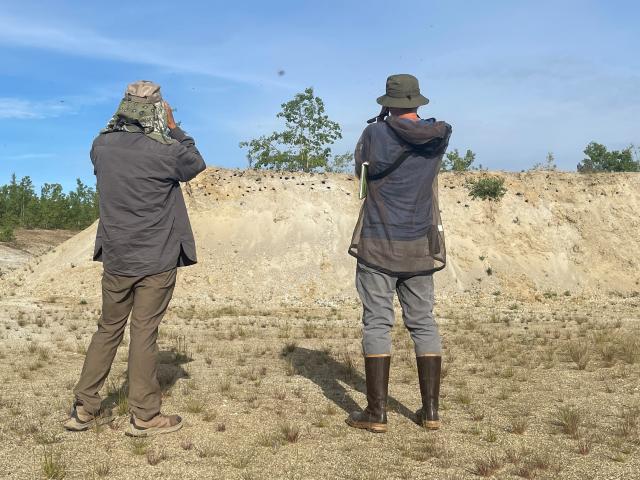You are viewing ARCHIVED content published online before January 20, 2025. Please note that this content is NOT UPDATED, and links may not work. Additionally, any previously issued diversity, equity, inclusion or gender-related guidance on this webpage should be considered rescinded. For current information, visit https://www.blm.gov/blog.
Acoustic bird monitoring: science’s surprising solution to a complex problem
With their small size and muted colors, it may be hard to imagine bank swallows (Riperia riperia) causing complications for those around them; but looks can be deceiving. These small birds nest together in colonies, digging nesting burrows up to five feet long that end in grass-lined chambers to lay their eggs. When bank swallows opt for their natural nesting habitats in sandy banks, little of note occurs aside from the expected consequence of more baby birds. But take several hundred of these egg hidey-holes and apply them to the artificial habitat of mineral material stockpiles in gravel pits used by the Alaska Department of Transportation, and the issue becomes more complicated.
We can’t blame the swallows for colonizing piles of gravel; the materials may as well be a ready-made nursery. Unfortunately, the bank swallow nesting season ranges from April or May, with most of their young reaching fledgling age by mid-July. This also happens to be when the stockpiles are used for road and pipeline maintenance during the short summer construction season. The confluence of nesting and summer construction seasons creates something of a quandary for land managers and operators alike.
Mineral material sites are common along the Dalton Highway Utility Corridor and provide critical resources for maintaining roadway and pipeline infrastructure. The stockpiles create artificial nesting habitat that bank swallows readily colonize, but when stockpiles are needed for road and pipeline maintenance the Migratory Bird Treaty Act prohibits their use until after the young have fledged. Bank swallows have been documented using these sites; however, there have been no systematic surveys to determine the status, distribution, or nesting phenology of bank swallows at gravel pits or natural colonies in the region.
After a bank swallow colony living in a stockpile was destroyed during the 2020 nesting season, the BLM needed better data on migratory bird phenology in areas with BLM-permitted activities. Determining when exactly the birds arrive and when the young fledge will enable the BLM to potentially shorten the timing limitation on use of stockpiles with active colonies.
In 2023, the BLM began working with the Institute for Bird Populations to track and monitor bird activity in gravel pits along the Dalton Highway Utility Corridor spanning a habitat gradient from the boreal forest just north of the Yukon River to the expanse of Arctic tundra north of the Brooks Range. Using Automated Recording Units (ARUs) to collect acoustic data, researchers have located 13 sites with evidence of bank swallow presence and an additional 19 sites with potential bank swallow nesting habitat. All these sites were mineral materials sites that included cut banks or piles of sandy material that may be attractive to nesting bank swallows.

Researchers did not locate bank swallow colonies at any of the natural cut riverbank habitats where ARUs were used. In total, the team deployed 69 ARUs at 65 unique monitoring points along the Dalton Highway. These devices detected bank swallows at 36 (55%) of the 65 sites, although most detections were from just a few active colonies. Burrow counts at colonies ranged from 2 to 128, and ARU detection rates were correlated with these burrow counts. Bank swallow activity showed two diurnal peaks (mid-morning and late evening).

During this initial year of monitoring, an abbreviated sampling window was completed that did not capture arrival or departure times. Nevertheless, researchers were able to capture a seasonal peak in bank swallow activity that likely corresponded to fledging times. Based on the four colonies with the most data, this peak differed by as much as 1-week between the farthest south site and sites farther north, with peaks between July 16 and 23.
Research is still ongoing, but a preliminary summary of acoustic data suggests detections of 107 bird species. Summer 2024 is the first full field season with a projected project completion date in 2026. In 2024, researchers are planning to increase the temporal time window sampled to include the arrival phenology of birds in spring and departure in late summer. This data will help the BLM develop succinct timing limitations to protect wildlife resources and better enable permittees to fulfill infrastructure maintenance needs with public resources. Together, the BLM and the Institute for Bird Populations aim to better understand the breeding ecology of bank swallows along the Dalton Highway to fulfill BLM’s multiple use sustained yield mission with minimal impacts to nesting birds – a win all around!


This story is part of the “Unleashing the Science” series, showcasing how bureaus within the Department of the Interior produce and apply science to ensure responsible management decisions for our planet now and for the future.
Azure Hall, Public Affairs Specialist and Erin Julianus, Wildlife Biologist
